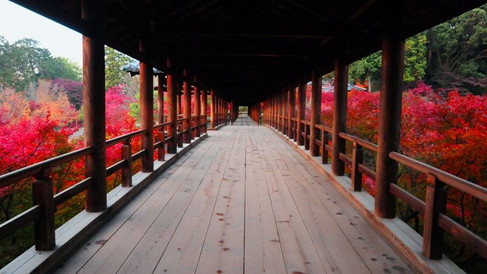The Legacy of Tōfuku-ji Temple
- shan157
- 3 days ago
- 4 min read
Established in 1236 by an imperial chancellor with ambitions to rival Nara’s grand temples, Tōfuku-ji rose as a monumental testament to Kyoto’s spiritual and architectural aspirations. At its helm was Enni Ben’en (1202–1280), a revered monk fresh from China, where he had immersed himself in Rinzai Zen teachings. Under his guidance, Tōfuku-ji became one of Kyoto’s Five Great Zen Temples, an enduring symbol of Zen’s deep roots in Japan.

Although much of the original complex was lost to fire in the 14th century, many of Tōfuku-ji’s compounds and sub-temples weathered centuries of turmoil, standing firm through war and time until the late Meiji period. Painstakingly reconstructed using the original blueprints, the temple today echoes the grandeur of medieval Zen architecture. Its grounds are home to around 25 sub-temples, a tapestry of exquisite gardens and more than 2,000 trees that shift with the seasons.

Rising 22 metres high at the foot of Mt. Enichi, the Sanmon Gate commands attention as the largest and oldest surviving Zen gate in all of Japan. It was originally built in 1236 as part of the grand vision for Tōfuku-ji but like many of the temple’s early structures, it eventually succumbed to fire. The gate we see today was meticulously rebuilt in 1425, during a period of cultural and architectural revival. With its intricate wooden joinery and imposing scale, it stands as a powerful symbol of Zen resilience and aesthetic precision. Nearly five centuries later, its cultural and historical significance was formally recognised when it was designated a National Treasure, a title that honours not just the gate itself but the legacy it represents.

While the gate is revered today for its architectural majesty and spiritual symbolism, legend tells of a time when its steps ran red with blood. Long ago, during one of Japan’s turbulent periods of civil strife, the very stones where monks once sat in silent meditation became a site of grim executions. The stillness of Zen gave way to violence and the serenity of the gate was tainted by death. Locals say the moss covered stones have not forgotten. When the rain falls just right, a rust-coloured stain emerges from between the cracks, as if the earth itself is remembering. According to legend, it is the blood of the condemned, drawn back to the surface by memory and moisture. Though historians remain cautious, the story endures, passed down through whispers and woven into the very fabric of the temple’s atmosphere.
Tōfuku-ji may now be a sanctuary of stillness, where maple leaves blaze crimson in autumn and Zen gardens offer quiet refuge but beneath its calm facade lies a history soaked in blood. During the Onin War of 1467, Kyoto erupted into brutal civil conflict. The city’s temples, once places of peace, became battlegrounds and Tōfuku-ji was caught in the storm. As rival samurai clans clashed in the streets, the temple's sacred grounds were overrun. Steel met flesh beneath the eaves and chants of sutras gave way to screams. Monks, unwavering in their duty, refused to flee. They were cut down without mercy, slaughtered in their robes, their bodies strewn across the meditation halls and courtyards. Blood pooled beneath the prayer mats and soaked into the gravel paths. The once-tranquil compound became a field of carnage, the scent of incense replaced by the stench of death.

The picturesque Tsutenkyo Bridge
The most iconic feature of Tōfuku-ji is the Tsūten-kyō or “Bridge to Heaven”, a covered walkway that spans the Sengyokukan Gorge, where thousands of Japanese maples blaze red in Autumn, drawing crowds eager to witness the fiery spectacle. But beneath its serene beauty lies a far more sinister past. During the violent Sengoku period of the 16th century, this very bridge became an execution site. Those who defied the ruling samurai, rebels, dissenters and monks, were marched across not to admire the view but to die. Some were beheaded on the spot, while others were cast into the gorge below, their final cries lost in the rustle of leaves. Today, the bridge is silent and still but the air carries a weight, an invisible residue of fear and finality that lingers beneath the surface of its beauty.

Location : 15-778 Honmahi, Higashiyama-ku, Kyoto, Japan
How to get there : Tofukuji is a ten minute walk from Tofukuji Station on the JR Nara Line (2 minutes, 140 yen from Kyoto Station) and the Keihan Main Line. Alternatively, the temple is a ten minute walk from Tofukuji bus stop (15 minutes, 230 yen from Kyoto Station by Kyoto City Bus 208).
Attraction Info : This temple complex is open between 9am to 4:30pm from April to October, 8:30am to 4:30pm from November to early December and 9am to 4pm between early December to March. Admission to the grounds ends 30 minutes before closing time. Admission costs 400 yen for access to the Tsutenkyo Bridge and Kaisando Hall) and 400 yen to see Hojo and the gardens.
東福寺
Official Website : www.tofukuji.jp/english
Thanks for reading The Legacy of Tōfuku-ji Temple. Check out more destinations here!





























